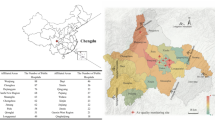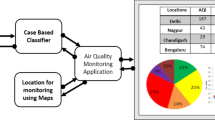Abstract
The association of air pollution and the magnitude of adverse health effects are receiving close attention from the world. The effects of air pollution were found to be most significant for children, elderly, and patients with preexisting respiratory problems. The existing API forecast system is capable of predicting the air quality based on the pollutant concentrations before critical levels of air pollution are exceeded. However, there is no API forecasting system available in Malaysia that can predict the coming day API readings. This paper aims to propose an API forecast system that utilizes the hourly API in Malaysia to predict the next day API. The proposed solution allows sensitive populations to plan ahead of their daily activities and provide governments with information for public health alerts. We also propose strategies for aggregated-level predictions within the region. Nevertheless, it can be extended across the region, especially in the less economically developed regions across the world. We conduct experiments on the public API dataset to demonstrate the viability of the proposed solution.




Similar content being viewed by others
References
World Health Organization (2016) Ambient air pollution: a global assessment of exposure and burden of disease. WHO. http://apps.who.int/iris/bitstream/10665/250141/1/9789241511353-eng.pdf. Accessed 1 June 2020
Ma D, Zhao T (2014) Talking about the current situation of air pollution in China and its governance recommendations. J Hebei Inst Arch Eng 32(2):53–54
Organization WH (2016) Air pollution levels rising in many of the world’s poorest cities. Switzerland, Geneva
Council M-AR (2019) 2019 Annual air quality awareness survey. ETC Institute, Olathe
Szyszkowicz M, Kousha T (2014) Emergency department visits for asthma in relation to the air quality health index: a case-crossover study in Windsor, Canada. Can J Public Health 105(5):e336–e341
Dalsøren SB, Jonson JE (2016) Socio-economic impacts—air quality, Chap 16. In: Quante M, Colijn F (Hrsg) (ed) North Sea region climate change assessment. Springer, Berlin, Heidelberg, pp 431–446
Beverland IJ, Cohen GR, Heal MR, Carder M, Yap C, Robertson C, Hart CL, Agius RM (2012) A comparison of short-term and long-term air pollution exposure associations with mortality in two cohorts in Scotland. Environ Health Perspect 120(9):1280–1285
Organization WH (2018) Air pollution and child health: prescribing clean air: summary. World Health Organization, Geneva
Conforti A, Mascia M, Cioffi G, De Angelis C, Coppola G, De Rosa P, Pivonello R, Alviggi C, De Placido G (2018) Air pollution and female fertility: a systematic review of literature. Reprod Biol Endocrinol 16(1):117
Sastry N (2002) Forest fires, air pollution, and mortality in Southeast Asia. Demography 39(1):1–23
Dominick D, Juahir H, Latif MT, Zain SM, Aris AZ (2012) Spatial assessment of air quality patterns in Malaysia using multivariate analysis. Atmos Environ 60:172–181
Ogawa H (1998) The Haze Episode of 1997 in Countries of South-East Asia, pp 416–428
Afroz R, Hassan MN, Ibrahim NA (2003) Review of air pollution and health impacts in Malaysia. Environ Res 92(2):71–77
Murad MW, Pereira JJ (2011) Malaysia: environmental health issues. In: Nriagu JO (ed) Encyclopedia of environmental health. Elsevier, Burlington, pp 577–594. http://www.sciencedirect.com/science/article/pii/B9780444522726005390. Accessed 5 May 2020
Malaysia DoE (2000) A guide to air pollutant index (API) in Malaysia. https://issuu.com/universititeknologimalaysia/docs/a_guide_to_pollutant_index__api__in
Ya'acob N, Zainuddin A, Abidin IFZ, Yusof AL, Idris A (2016) Web-based real time haze monitoring system. In: 2016 6th IEEE International Conference on Control System, Computing and Engineering (ICCSCE). IEEE, pp 51–55
Carnevale C, De Angelis E, Finzi G, Turrini E, Volta M (2019) An integrated forecasting system for air quality control. In: 2019 18th European Control Conference (ECC). IEEE, pp 830–835
Carnevale C, Finzi G, Pisoni E, Singh V, Volta M (2011) An integrated air quality forecast system for a metropolitan area. J Environ Monit 13(12):3437–3447
Carnevale C, Finzi G, Pederzoli A, Turrini E, Volta M (2016) Lazy Learning based surrogate models for air quality planning. Environ Model Softw 83:47–57
Azmi SZ, Latif MT, Ismail AS, Juneng L, Jemain AA (2010) Trend and status of air quality at three different monitoring stations in the Klang Valley, Malaysia. Air Qual Atmos Health 3(1):53–64
Azid A, Juahir H, Toriman ME, Endut A, Kamarudin MKA, Rahman MNA, Hasnam CNC, Saudi ASM, Yunus K (2015) Source apportionment of air pollution: a case study in Malaysia. J Teknol 72(1):83–88
Suparta W, Alhasa KM, Singh MSJ, Latif MT (2015) The development of PWV index for air pollution concentration detection in Banting, Malaysia. In: 2015 International Conference on Space Science and Communication (IconSpace). IEEE, pp 498–502
Coles S, Bawa J, Trenner L, Dorazio P (2001) An introduction to statistical modeling of extreme values, 208th edn. Springer, London
Chin YSJ, De Pretto L, Thuppil V, Ashfold MJ (2019) Public awareness and support for environmental protection—a focus on air pollution in peninsular Malaysia. PLoS ONE 14(3):e0212206
Anjum SS, Noor RM, Aghamohammadi N, Ahmedy I, Kiah LM, Hussin N, Anisi MH, Qureshi MA (2019) Modeling traffic congestion based on air quality for greener environment: an empirical study. IEEE Access 7:57100–57119
Ya'acob N, Azize A, Adnan NM, Yusof AL, Sarnin SS (2016) Haze monitoring based on air pollution index (API) and geographic information system (GIS). In: 2016 IEEE Conference on Systems, Process and Control (ICSPC). IEEE, pp 7–11
EPA U (1997) Ambient air monitoring reference and equivalent methods. Federal Register 40 CFR Parts, p 50. https://www.federalregister.gov/documents/2020/05/07/2020-09704/ambient-air-monitoring-reference-and-equivalent-methods-designation-of-one-new-equivalent-method
Hesketh HD (1996) Air Pollution Control: Traditional Hazardous Pollutants. CRC Press, Boston
Martín MJ, Parada M, Doallo R (2004) High performance air pollution simulation using OpenMP. J Supercomput 28(3):311–321
Yang C-T, Chan Y-W, Liu J-C, Lou B-S (2020) An implementation of cloud-based platform with r packages for spatiotemporal analysis of air pollution. J Supercomput 76(3):1416–1437
Bai L, Wang J, Ma X, Lu H (2018) Air pollution forecasts: an overview. Int J Environ Res Public Health 15(4):780
Sinnott RO, Guan Z (2018) Prediction of air pollution through machine learning approaches on the cloud. In: 2018 IEEE/ACM 5th International Conference on Big Data Computing Applications and Technologies (BDCAT). IEEE, pp 51–60
Karimian H, Li Q, Wu C, Qi Y, Mo Y, Chen G, Zhang X, Sachdeva S (2019) Evaluation of different machine learning approaches to forecasting PM2.5 mass concentrations. Aerosol Air Qual Res 19(6):1400–1410
Siew LY, Chin LY, Wee PMJ (2008) ARIMA and integrated ARFIMA models for forecasting air pollution index in Shah Alam, Selangor. Malays J Anal Sci 12(1):257–263
ABD Rahman NH, Lee MH, Suhartono LM (2016) Evaluation performance of time series approach for forecasting air pollution index in Johor, Malaysia. Sains Malays 45(11):1625–1633
Zakaria NN, Othman M, Sokkalingam R, Daud H, Abdullah L, Abdul Kadir E (2019) Markov chain model development for forecasting air pollution index of Miri, Sarawak. Sustainability 11(19):5190
Alyousifi Y, Othman M, Sokkalingam R, Faye I, Silva PC (2020) Predicting daily air pollution index based on fuzzy time series Markov chain model. Symmetry 12(2):293
Author information
Authors and Affiliations
Corresponding author
Additional information
Publisher's Note
Springer Nature remains neutral with regard to jurisdictional claims in published maps and institutional affiliations.
Rights and permissions
About this article
Cite this article
Wong, KS., Chew, Y.J., Ooi, S.Y. et al. Toward forecasting future day air pollutant index in Malaysia. J Supercomput 77, 4813–4830 (2021). https://doi.org/10.1007/s11227-020-03463-z
Accepted:
Published:
Issue Date:
DOI: https://doi.org/10.1007/s11227-020-03463-z




